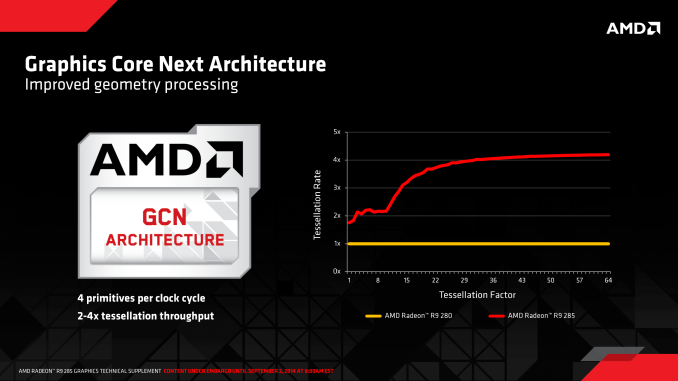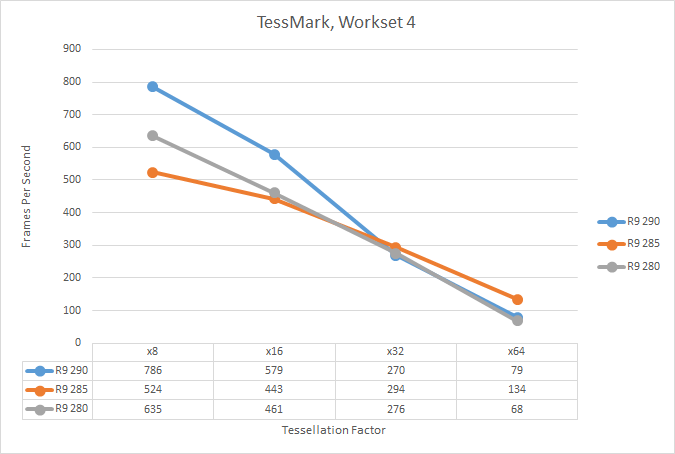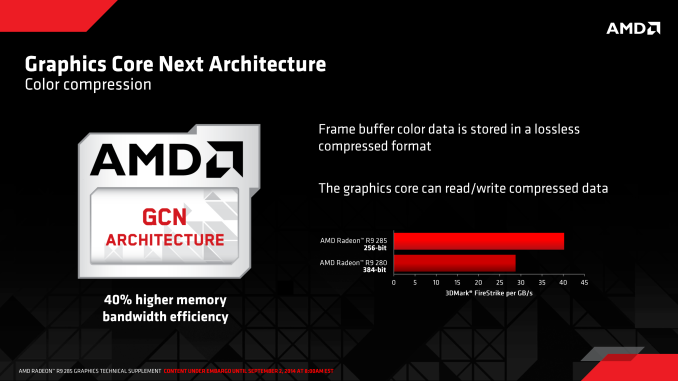AMD Radeon R9 285 Review: Feat. Sapphire R9 285 Dual-X OC
by Ryan Smith on September 10, 2014 2:00 PM ESTGCN 1.2: Geometry Performance & Color Compression
Instruction sets aside, Radeon R9 285 is first and foremost a graphics and gaming product, so let’s talk about what GCN 1.2 brings to the table for those use cases.
Through successive generations of GPU architectures AMD has been iterating on and improving their geometry hardware, both at the base level and in the case of geometry generated through tessellation. This has alternated between widening the geometry frontends and optimizing the underlying hardware, with the most recent update coming in the GCN 1.1 based Hawaii, which increased AMD’s geometry processor count at the high end to 4 processors and implemented some buffering enhancements.
For Tonga AMD is bringing that 4-wide geometry frontend from Hawaii, which like Hawaii immediately doubles upon Tahiti’s 2-wide geometry frontend. Not stopping there however, AMD is also implementing a new round of optimizations to further improve performance. GCN 1.2’s geometry frontend includes improved vertex reuse (for better performance with small triangles) and improved work distribution between the geometry frontends to better allocate workloads between them.
At the highest level Hawaii and Tonga should be tied for geometry throughput at equivalent clockspeeds, or roughly 2x faster than Tahiti. However in practice due to these optimizations Tonga’s geometry frontend is actually faster than Hawaii’s in at least some cases, as our testing has discovered.
Comparing the R9 290 (Hawaii), R9 285 (Tonga), and R9 280 (Tahiti) in TessMark at various tessellation factors, we have found that while Tonga trails Hawaii at low tessellation factors – and oddly enough even Tahiti – at high tessellation factors the tables are turned. With x32 and x64 tessellation, the Tonga based R9 285 outperforms both cards in this raw tessellation test, and at x64 in particular completely blows away Hawaii, coming close to doubling its tessellation performance.
At the x64 tessellation factor we see the R9 285 spit out 134fps, or equivalent to roughly 1.47B polygons/second. This is as compared to 79fps (869M Polys/sec) for the R9 290, and 68fps (748M Polys/sec) for the R9 280. One of the things we noted when initially reviewing the R9 290 series was that AMD’s tessellation performance didn’t pick up much in our standard tessellation benchmark (Tessmark at x64) despite the doubling of geometry processors, and it looks like AMD has finally resolved that with GCN 1.2’s efficiency improvements. As this is a test with a ton of small triangles, it looks like we’ve hit a great case for the vertex reuse optimizations.
Meanwhile AMD’s other GCN 1.2 graphics-centric optimization comes at the opposite end of the rendering pipeline, where the ROPs and memory controllers lie. As we mentioned towards the start of this article, one of the notable changes between the R9 280 and R9 285 is that the latter utilizes a smaller 256-bit memory bus versus the R9 280’s larger 384-bit memory bus, and as a result has around 27% less memory bandwidth than the R9 280. Under most circumstances such a substantial loss in memory bandwidth would result in a significant performance hit, so for AMD to succeed Tahiti with a smaller memory bus, they needed a way to be able to offset that performance loss.
The end result is that GCN 1.2 introduces a new color compression method for its ROPs, to reduce the amount of memory bandwidth required for frame buffer operations. Color compression itself is relatively old – AMD has had color compression in some form for almost 10 years now – however GCN 1.2 iterates on this idea with a color compression method AMD is calling “lossless delta color compression.”
Since AMD is only meeting us half-way here we don’t know much more about what this does. Though the fact that they’re calling it delta compression implies that AMD has implemented a further layer of compression that works off of the changes (deltas) in frame buffers, on top of the discrete compression of the framebuffer. In this case this would not be unlike modern video compression codecs, which between keyframes will encode just the differences to reduce bandwidth requirements (though in AMD’s case in a lossless manner).
AMD’s own metrics call for a 40% gain in memory bandwidth efficiency, and if that is the average case it would more than make up for the loss of memory bandwidth from working on a narrower memory bus. We’ll see how this plays out over our individual games over the coming pages, but it’s worth noting that even our most memory bandwidth-sensitive games hold up well compared to the R9 280, never losing anywhere near the amount of performance that such a memory bandwidth reduction would imply (if they lose performance at all).














86 Comments
View All Comments
TiGr1982 - Thursday, September 11, 2014 - link
BTW, is Tonga the only new GPU AMD has to offer in 2014?(if I'm not mistaken, the previous one from AMD, Hawaii, was released back in October 2013, almost a year ago)
Does anybody know?
HisDivineOrder - Thursday, September 11, 2014 - link
The thing is the moment I heard AMD explaining how Tonga was too new for current Mantle applications, I was like, "And there the other shoe is dropping."The promise of low level API is that you get low level access and the developer gets more of the burden of carrying the optimizations for the game instead of a driver team. This is great for the initial release of the game and great for the company that wants to have less of a (or no) driver team, but it's not so great for the end user who is going to wind up getting new cards and needing that Mantle version to work properly on games no longer supported by their developer.
It's hard enough getting publishers and/or developers to work on a game a year or more after release to fix bugs that creep in and in some cases hard to get them to bother with resolution switches, aspect ratio switches, the option to turn off FXAA, the option to choose a software-based AA of your choice, or any of a thousand more doohickeys we should have by now as bog-standard. Can you imagine now relying on that developer--many of whom go completely out of business after finishing said title if they happen to work for Activision or EA--to fix all the problems?
This is why a driver team is better working on it. Even though the driver team may be somewhat removed from the development of the game, the driver team continues to have an incentive to want to fix that game going forward, even if it's a game no longer under development at the publisher. You're going to be hard pressed to convince Bobby Kotick at Activision that it's worth it to keep updating versions of games older than six months (or a year for Call of Duty) because at a certain point, they WANT you to move on to another game. But nVidia and AMD (and I guess Intel?) want to make that game run well on next gen cards to help you move.
This is where Mantle is flawed and where Mantle will never recover. Every time they change GCN, it's going to wind up with a similar problem. And every time they'll wind up saying, "Just switch to the DX version." If Mantle cannot be relied upon for the future, then it is Glide 2.0.
And why even bother at all? Just stick with DirectX from the get-go, optimize for it (as nVidia has shown there is plenty of room for improvement), and stop wasting any money at all on Mantle since it's a temporary version that'll rapidly be out of date and unusable on future hardware.
The-Sponge - Thursday, September 11, 2014 - link
I do not understand how they got there R9 270x temperatures, my OC'd R9 270x never even comes close to the temps they got....mac2j - Friday, September 12, 2014 - link
It's great that they've caught up with H.264 on hardware and the card otherwise looks fine. The bottom line for me, though, is that I don't see the point of buying card now without H.265 on hardware and an HDMI 2.0 port - 2 things Maxwell will bring this year. I haven't heard what AMDs timetable is there though.P39Airacobra - Friday, October 17, 2014 - link
It really irritates me that they are making these cards throttle to keep power and temps down! That is pathetic! If you can't make the thing right just don't make it! Even if it throttles .1mhz it should not be tolerated! We pay good money for this stuff and we should get what we pay for! It looks like the only AMD cards worth anything are the 270's and under. It stinks you have to go Nvidia to get more power! Because Nvidia really rapes people with their prices! But I must say the GTX 970 is priced great if it is still around $320. But AMD should have never even tried with this R9 285! First of all when you pay that much you should get more than 2GB. And another thing the card is pretty much limited to the performance of the R9 270's because of the V-Ram count! Yeah the 285 has more power than the 270's, But whats the point when you do not have enough V-Ram to take the extra power were you need a card like that to be? In other words if you are limited to 1080p anyway, Why pay the extra money when a R7 265 will handle anything at 1080p beautifully? This R9 285 is a pointless product! It is like buying a rusted out Ford Pinto with a V-8 engine! Yeah the engine is nice! But the car is a pos!P39Airacobra - Friday, January 9, 2015 - link
(QUOTE) So a 2GB card is somewhat behind the times as far as cutting edge RAM goes, but it also means that such a card only has ¼ of the RAM capacity of the current-gen consoles, which is a potential problem for playing console ports on the PC (at least without sacrificing asset quality).(SIGH) So now even reviewers are pretending the consoles can outperform a mid range GPU! WOW! How about telling the truth like you did before you got paid off! The only reason a mid range card has problems with console ports is because they are no longer optimized! They just basically make it run on PC and say xxxx you customers here it is! And no the 8GB on the consoles are used for everything not for only V-Ram! We are not stupid idiots that fall for anything like the idiots in Germany back in the 1930's!